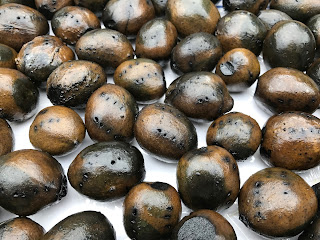These lovely long days are bringing on everything in my courtyard garden. This
Tayberry is starting to ripen now. A
Tayberry is a cross between a Raspberry and a Blackberry. I am eating these every day straight from the plant so that the birds don't get there before me.
Without the aid of a greenhouse these
Sungold cherry tomatoes are just beginning to ripen. These really are one of the best tasting tomatoes. Even though they are an F1 variety and seeds can be costly, they really are worth it.
This little cucumber
Carmen , is growing bigger by the day. There is a cucumber on every single leaf joint so if I can keep it well fed and watered it is going to be quite prolific.
I have a
Morello cherry tree up against the West facing brick wall of the house. I have bought some netting to cover them. The will start to ripen to a dark purple almost black colour soon. Must get a move on and get all that netting up.
Still early days yet but this bush
courgette Romanesco is just beginning to show. Again, a really prolific bush variety from Seeds of Italy. Experience as well as trial and error have shown me which varieties of fruit and veggies grow well for me in my own situation.
In between the tomato plants in the grow bags I have planted quite a few clumps of Genovese Basil. These make good companion plants as well as making a tasty accompaniment to tomato!
Romanesco Courgettes do well in this South facing container up against a brick wall. As long as they are fed and watered, they will do well here.























